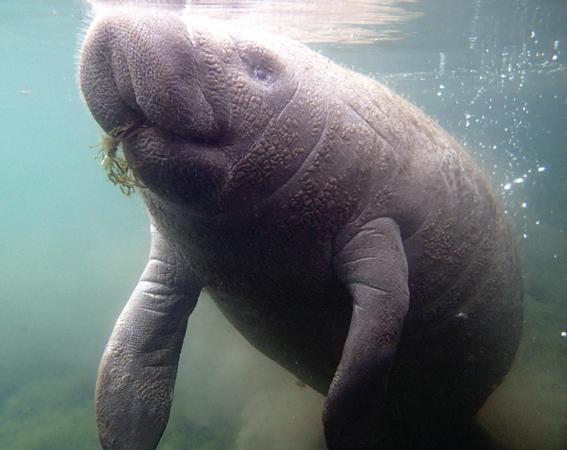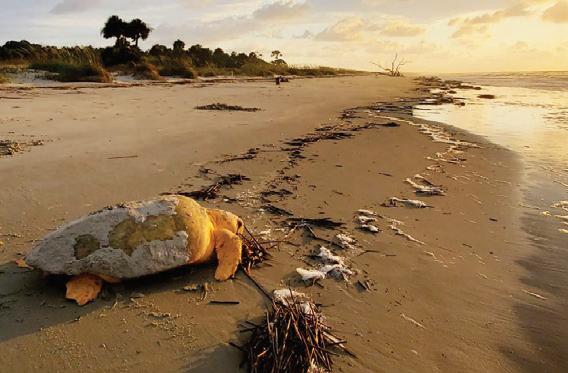
8 minute read
Wildlife Annual Report
The Georgia DNR's Wildlife Conservation Section (WCS) conserves and protects wildlife species not hunted or fished for, and native plants and their habitats through public education, research and management. The following are excerpts from their 2021 annual report. To read it in its entirety visit: bit.ly/2021_WildlifeReport
Florida Manatees
Advertisement
Florida manatees inhabit tidal rivers, estuaries and near-shore ocean waters throughout coastal Georgia during the warm months of the year. The Florida manatee population numbers approximately 8,000.
A collapse in seagrass resources in Brevard and nearby Florida counties led to the death of more than 650 manatees during January through May. Deaths subsided during summer 2021 as manatees were able to disperse and find food in other parts of Florida and Georgia, but there is concern that mortalities will resume in 2022 when the water cools and manatees return to natural and artificial warm-water sites with poor forage.
Manatee management in Georgia focuses on reducing humanrelated mortality and protecting habitat. Recovery tasks include documenting causes of mortality and injury, rescuing injured and out-of-habitat manatees, monitoring distribution and habitat use, educating boaters about watercraft impacts and reviewing permits and policies that may affect manatees and their habitat.
Wildlife Conservation staff have documented 103 manatee mortalities in Georgia waters since 2000. The leading causes of mortality are watercraft collisions (28 percent) and cold stress/ hypothermia (13 percent). Less common causes include drowning in commercial fishing gear, entrapment and gunshot. Ten manatee carcasses were found in Georgia during calendar year 2020 and the first half of 2021. Three died from starvation during the spring of 2021 – likely in connection with the seagrass die-off in Florida.
Two manatees died from watercraft collisions. The cause of death could not be determined in the remaining cases.
North Atlantic Right Whales
North Atlantic right whales are a critically endangered species that numbers only about 350 whales. The species was nearly driven to extinction by centuries of hunting and has been slow to recover because of reduced genetic diversity, natural variability in food resources and human impacts, including collisions with ships and entanglement in commercial fishing rope.
Right whales forage on zooplankton along the coast of New England and Canada. Each November through January, pregnant females migrate more than 1,000 miles to the coast of Georgia and northeast Florida, the species’ only known calving grounds. Females nurse their calves for one to two months, until the calves are strong enough to migrate north during February to April. A variable number of non-calving right whales also migrate to the southeastern U.S. each winter. The migrant whales do not feed in southeastern waters, instead relying on energy stored in their thick blubber.
The North Atlantic right whale population increased by more than 40 percent during the 2000s, suggesting the species was beginning to recover. However, in 2010 calving rates began to drop in response to changes in zooplankton distribution in New England and Canada – changes apparently driven by warming ocean temperatures and associated shifts in ocean currents. At the same time, right whales began suffering unprecedented levels of mortality and injury. An estimated 133 whales died from 2010 to 2017. Necropsies have found that most whales are dying from ship strikes and entanglement in commercial fishing gear. More than 80 percent of surviving whales bear scars from fishing rope entanglements.
Even worse, females are dying at faster rates than males, probably because of the added energy that calving demands. Fewer than 100 calving females remain. The species is declining rapidly, and its future is uncertain. Data from the North Atlantic Right Whale Consortium placed the species at 356 whales as of 2020, down from a peak of 481 in 2011.
During the 2021 calving season, survey teams identified 17 females with calves, 17 adult females without calves,12 adult males and nine juvenile whales. An additional cow/calf pair was spotted in New England waters in spring 2021, upping the annual calf total to 18. The 2021 counts were a welcomed increase compared to recent winters, raising hope that the whales may finally be finding adequate plankton in New England and Canada. (No calves were seen in 2018, the first time none had been reported since surveys began in the 1980s.)
However, the 2021 calving season was far from perfect. One calf was killed and its mother injured when the pair were hit by a sportfishing boat near St. Augustine, Fla., in February. Two entangled whales were also spotted. Wildlife Conservation staff tried to free an adult male right whale from a lobster pot in January, but the whale evaded the boat and may now be dead.
Another male was found entangled in heavy rope off Florida in February but died off the South Carolina coast before responders could help it. Both whales likely became entangled in fishing gear from New England or Canada.
Until calving rebounds to normal levels, reducing human causes of mortality is key to the species’ survival.

Sea Turtles
Loggerhead sea turtles are found in Georgia’s coastal waters yearround and nest on all barrier island beaches. Since comprehensive surveys were established in 1989, loggerhead nesting has been highly variable, with an average of 1,510 nests per year. In 2021, more than 2,484 loggerhead nests were documented on Georgia beaches. Nesting was slightly above the 32-year average and below the recovery goal of 2,800 nests a year, the target set in the National Marine Fisheries Service/U.S. Fish and Wildlife Service recovery plan of 2008.
To develop a comprehensive understanding of the number and relatedness of loggerheads nesting on Georgia beaches, DNR and the University of Georgia created a catalog of unique genetic profiles for Georgia’s nesting female turtles. Dr. Brian Shamblin, working with DNR staff, has identified an average of 715 loggerhead females using the Georgia coast annually from 2008-2020, with a range of 303 to 1,093 turtles per year. A genetic sample was collected from every known nest deposited in Georgia in 2021. The ongoing project is providing a better understanding of loggerhead nesting ecology and interpretation of nesting trends.
Sea Turtle Stranding and Salvage Network
The Wildlife Conservation Section monitors sea turtle mortality through the Sea Turtle Stranding and Salvage Network. Systematic patrols of barrier island beaches provide information on the number and species of dead turtles that wash up on the Georgia coast. When possible, necropsies of stranded turtles are done to evaluate causes of mortality. Sea turtle strandings are the primary index of threats to sea turtles in the state’s coastal waters.
In fiscal year 2021, 96 dead or injured turtles were documented on Georgia beaches. That total is below the 30-year average of 176 strandings per year.
Overall, strandings have declined by approximately 5 percent annually over the last 40 years during a period of increasing sea turtle abundance. The use of TEDs in the shrimp trawl fishery is partially responsible for the overall decline. Results from necropsy examinations indicate that boat collisions and commercial fishery mortality are the leading sources of mortality, accounting for 33 percent of strandings in fiscal 2021.
The public is encouraged to report stranded sea turtles in Georgia by contacting DNR at 800-2-SAVE-ME (800-272-8363). Stranding updates are available at seaturtle.org/strand/ summary (pick Georgia from “Select a Program”).
Waterbirds
Conservation actions include protecting and managing five sand islands for beach-nesting and migratory birds. One of the areas, a dredge-spoil island near Brunswick called Bird Island, supports one of the largest colonies of nesting seabirds on the southern Atlantic Coast. Given the recent degradation of these offshore bar habitats, DNR is collaborating with the U.S. Army Corps of Engineers to create additional habitat through the beneficial use of dredge spoil. 2021 proved challenging for priority seabirds such as black skimmer and gull-billed terns. The continuing degradation of offshore bars led to complete losses of colonies because of tidal overwash on Ogeechee Bar, St. Catherines Island Bar and Little St. Simons. Predators wiped out colonies on Little Tybee and Cumberland islands. Also, Pelican Spit fully merged with Sea Island, making it unavailable for nesting birds.
Brown pelicans continued to grow in number on Little Egg Island Bar, with 749 nests and good chick productivity documented. Seventy pairs nested on Bird Island.
Overall, Bird Island was highly productive again, despite several oil spills from the MV Golden Ray wreck removal that reached the island and a number of birds becoming oiled. In addition to brown pelicans nesting on the island, peak counts included 8,083 royal terns, 447 sandwich terns, 300 laughing gulls, 107 black skimmers and 17 gull-billed terns. The black skimmers and gull-billed terns abandoned their nest attempts.
On Ogeechee Bar, approximately 500 royal terns managed to fledge young despite the flooding that impacted other species.
American oystercatcher productivity in Georgia slipped in 2021. DNR confirmed 28 chicks fledged and banded 24. Issues included the persistent overwash of offshore bars, the loss of Pelican Spit and coyotes returning to Little St Simons and Cumberland.
Wood Storks
2021 proved an average year. Staff documented 23 nesting colonies and 2,260 nesting pairs, almost the same as in 2020. Also, 17 wood storks were tagged. Most of these were chicks at the Gilman colony in St. Marys. One was a rehabilitated stork released by the Georgia Sea Turtle Center on Jekyll Island.
More than 75 percent of wood stork rookeries in Georgia are on private land. Conservation of this species depends on landowners’ willingness to ensure the protection of viable freshwater-wetland nesting sites.
Eagles
Since documenting a record 218 occupied nesting territories statewide in 2017, the Wildlife Conservation Section has surveyed about half to two thirds of the state’s eagle nesting areas each year. The change maintains a standardized survey scheme without compromising the agency’s ability to detect and respond to notable changes in bald eagle productivity.
Some of the survey flights scheduled in 2021 were canceled because of concerns about COVID-19.
As a result, only the six coastal counties were surveyed, leading to the detection and monitoring of 71 nests with an additional 12 inland nests monitored largely by volunteers. Coastal nests fledged 81, which is an average success rate. 77 percent of the total 83 nests fledged at least one eaglet. Nine new nest territories were found, six of which were in the coastal counties.










